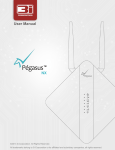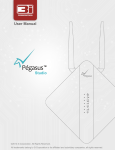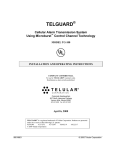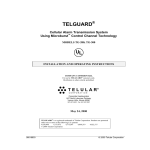Download Pegasus NX
Transcript
Installation Manual ™ NX ©2013 3i-Corporation. All Rights Reserved. All trademarks belong to 3i-Corporation or its affiliated and subsidiary companies, all rights reserved. NX Installation Manual | June 2013 ETHERNET GPRS WI-FI © 2013 3i-Corporation® and its affiliated and subsidiary companies, all rights reserved. All other trademarks are the property of 3i-Corporation and its affiliated and subsidiary companies. This product, including software, data and documentation are licensed to the user for its internal business purposes only and may not be disclosed, disseminated, sold, licensed, copied, reproduced, translated or transferred to any third party. Brazil India Head Office Innovation & Technology Center [email protected] +55 11 38326102 Rua Coronel Botelho, 64 - Alto da Lapa - 05088-020 São Paulo – SP, BRAZIL [email protected] +91 80 42072044 +91 80 42033406 st #5, 1 Cross, Khykha Court, 1st Floor, Madiwala, Hosur Main Road, Bangalore , Karnataka - 560068 INDIA ii Table of Contents 1. Introduction ............................................................................................................. 1 1.1. Scope ....................................................................................................................................................... 1 1.2. Audience .................................................................................................................................................. 1 1.3. Contact Information or Comments ............................................................................................................ 1 1.4. Text Conventions ...................................................................................................................................... 2 2. Overview ................................................................................................................. 3 1.1. About the Installation Manual .................................................................................................................... 3 1.2. What is Pegasus™ NX? ........................................................................................................................... 3 3. Technical Specifications .......................................................................................... 5 Pegasus™ NX Features............................................................................................ 10 5. Pegasus NX Components Description .................................................................. 12 5.1. Pegasus™ NX Components ................................................................................................................... 12 6. Unbox Pegasus™ NX ........................................................................................... 16 8.1. How to Unbox Pegasus NX?................................................................................................................... 16 7. Install Battery ........................................................................................................ 18 8.1. How to Install Battery? ............................................................................................................................ 18 8. Install Antennas..................................................................................................... 21 8.1. Requirements ......................................................................................................................................... 21 8.2. How to Install the Wi-Fi and GSM Antennas? ......................................................................................... 22 9. Install SIM Cards ................................................................................................... 23 9.1. Requirements ......................................................................................................................................... 23 9.2. How to Install SIM Cards? ...................................................................................................................... 24 How to Mount Pegasus NX? .................................................................................... 28 10.1. Mounting Instructions ............................................................................................................................ 28 iii 10.2. Requirements ....................................................................................................................................... 28 10.3. Mount Bracket on a Masonry Wall ........................................................................................................ 29 10.4. Fix Pegasus™ NX on the Wall Bracket ................................................................................................. 30 11. Connect Ethernet Cable to RJ45 Port ................................................................. 34 11.1. Connection Instructions................................................................................................................. 34 11.2. Requirements ............................................................................................................................... 34 11.3. How to Connect Serial RS-232 Cable to UART Port? ................................................................... 35 12. Connect Serial RS-232 Cable to UART Port ...................................................... 36 12.1. Connection Instructions ........................................................................................................................ 36 12.2. Requirements ....................................................................................................................................... 36 12.3. How to Connect Serial RS-232 Cable to UART Port? ........................................................................... 37 13. Connect USB B Cable to USB B Port ................................................................. 38 13.1. Connection Instructions ........................................................................................................................ 38 13.2. Requirements ....................................................................................................................................... 38 13.3. How to Connect Serial RS-232 Cable to UART Port? ........................................................................... 39 How to Connect Pegasus™ NX? ............................................................................. 40 14.1. Wiring Instructions ................................................................................................................................ 40 14.2. Wiring Example..................................................................................................................................... 40 How to Wire Sensors/Detectors to Pegasus™ NX? .................................................. 42 15.1. Single-Mode: Normally Close (N.C.) Contacts without End of Line (EOL) Resistor ............................... 46 15.2. Single-Mode: Normally Close (N.C.) Contacts with End of Line (EOL) Resistor .................................... 47 15.3. Single-Mode: Normally Open (N.O.) Contacts with End of Line (EOL) Resistor .................................... 48 15.4. Single-Mode: Normally Close (N.C.) Contacts without End of Line EOL Resistor, with Tamper Recognition ................................................................................................................................................... 49 15.5. Single-Mode: Normally Close (N.C.) Contact with End of Line (EOL) Resistor, with Tamper & Wire Fault Recognition........................................................................................................................................... 50 15.6. Double-Mode: Normally Close (N.C.) Contacts without End of Line (EOL) Resistor .............................. 51 15.7. Double-Mode: Normally Close (N.C.) Contacts without End of Line (EOL) Resistor, with Tamper Recognition ................................................................................................................................................... 52 15.8. Double-Mode: Normally Close (N.C.) Contacts with End of Line (EOL) Resistor, with Tamper & Wire Fault Recognition .................................................................................................................................. 53 15.9. Double-Mode: Parallel Connection........................................................................................................ 54 iv How Does LEDs Work? ............................................................................................ 55 16.1. LEDs Description .................................................................................................................................. 55 17. Appendix ............................................................................................................. 58 17.1. Abbreviation .......................................................................................................................................... 58 v 1 1. Introduction 1.1. Scope This Installation Manual is aimed in providing detailed information and complete listing as a reference to install Pegasus™ NX. 1.2. Audience This Installation Manual is intended for end users who are going to install Pegasus NX. The readers or end-users of this installation manual should be familiar with the Pegasus™ Studio - Configuration Tool and the Zeus™ Server. Note: To get information about the Pegasus™ Studio – Configuration Tool, refer the Pegasus™ Studio – User Manual and the Pegasus™ Studio – Quick Start Manual. To get information about the Zeus™ Server, refer the Zeus Server – User Manual and the Zeus™ Server – Quick Start Manual. 1.3. Contact Information or Comments For general contact, technical support, questions or comments to report documentation errors and suggestions, contact 3i-Corporation Technical Writing Team. Our aim is to make this installation manual as helpful as possible. Keep us informed of your comments and suggestions for improvements. 3i-Corporation appreciates feedback from the users of our information. 1 1.4. Text Conventions Begin Instruction: To begin a procedure under any topic, use a numbered list for points. Note: Provides a message or reminder related to a topic or section. Warning: Information provided under this section MUST be followed. Several different sources of power can be connected to your Pegasus™ NX. Disconnect all sources of power before servicing. Control units and associated equipments may be damaged by removing and/or inserting SIM cards, or interconnecting cables while the unit is energized. DO NOT attempt to install, service, or operate this unit until this manual is read and understood. Caution: To ensure proper unit operation, this product must be tested in accordance with 3i-Corporation standards. Reacceptance testing is required after any change, addition or deletion of unit components, or after any modification, repair or adjustment to unit hardware or wiring. Important: Provides important information related to a topic or section. Tip: Provides advice or suggestion related to a topic or section. Troubleshooting: Provides information to troubleshoot or fix any Pegasus™ NX related issues or problems. 2 2 2. Overview 1.1. About the Installation Manual This Installation Manual is to describe the Pegasus™ NX functionality, technical specifications, features, and installation instructions including components description, mounting, and wiring. 1.2. What is Pegasus™ NX? The Pegasus™ NX Alarm Panel Communicator is an extremely compact, robust device in terms of communication interface for alarm panels. It brings the most innovative and reliable technologies for data communication to the Fire and Intrusion Alarm Panels prepared to operate only with conventional telephone lines. The device is fully compatible with alarm panels that communicate using the contact ID protocol and provides high speed, reliable and low cost communication. It acts as a modem attached to any alarm system that passes digital information to a 24/7 alarm receiving center which is able to respond to the received signal. Transmission of real time Alarm Panel Events via Wi-Fi Network is possible on failure of other interfaces or when the preferred interface is Wi-Fi. Alteration of the device configuration and upgrade of its firmware (embedded software) is possible remotely via the secured Wi-Fi Network (WPA or WPA2). The device contains an additional LED that acts as Wi-Fi indicator. You can also receive debug messages through Wi-Fi. 4.3. How Does Pegasus™ NX (Ethernet+GPRS+Wi-Fi) Work? Pégasus™ Nx when energized enters the Ethernet TCP/IP (Intranet/Internet) or GSM operator network via GPRS (Data Channel) or Wi-Fi Network (as configured in the configuration tool), and though it establishes connection with the ZEUS Server. It creates an online communication channel between the monitored client and the Alarm Monitoring Station, allowing immediate transmission of all events generated by the alarm panel in the Contact ID Protocol. All information transmitted by the device is encrypted (AES Rijndael128/256 Bit ) ensuring maximum confidentiality 3 The Zeus™ Server, on the other hand, is a multitask software that works as a virtual receiver, capturing the events transmitted by the device and transmitting them to the monitoring software like a conventional receiver simulating the communication protocol of Ademco-685, Sur-Gard MLR2-DG, Sur-Gard vai TCP/IP, Domus-4, CM-PLUS, and Radionics D6600 receivers. In addition, the ZEUS Server performs an important role in system management, constantly checking the communication with the device (Online or Offline), customer's phone line, Internet link, monitoring station, etc. Any thirdparty alarm monitoring software can be used. 4 3 3. Technical Specifications Power Supply 1 Input Voltage Range 9VDC – 15VDC 2 Maximum Current 450mA Lithium-Polymer Capacity: 2000mAh 2 Battery Backup Up to 6 hours depending on network conditions ARM 32bit Cortex-M3 2 Speed 32Mhz Battery 1 Battery Type Processor 1 CPU Ethernet 1 Network Standard IEEE 802.3u compliant fast 3 Ethernet Ethernet Cable CAT5 MDI/MDI-X auto crossover 2 Data Rate Full Duplex, 10/100 Base TX Ethernet PHY TCP/IP, UDP/IP 4 Protocols 5 GSM/GPRS 1 Modem Quad-band EGSM 850 / 900 / 1800 / 1900 MHz 5 SIM Card Holder Dual SIM Support 2 Protocol Support TCP/IP or UDP/IP 6 Antenna: Impedance 50Ω 3 Antenna Type External 7 Antenna: Peak Gain 2.0 dBi 4 Antenna: Frequency Range 824-960MHz,17102170MHz 8 Antenna: Return Loss -4.4 dB 1 Network Standard EEE 802.11 b, g compliant 6 Security Types WPA, WPA2 2 Typical WLAN Sensitivity 88dBm at 8% PER, 11Mbps 7 Typical WLAN -74dBm at 10% PER, Transmit 54Mbps Power +19.5dBm at 11Mbps, CCK (11b) 3 WLAN Antenna: Type External 8 WLAN Antenna: Frequency Range 2.4 - 2.5GHz 4 WLAN Antenna: Impedance 50 Ω 9 WLAN Antenna: Return Loss 10 dB 5 WLAN Antenna: VSWR 2.0 Max 10 WLAN Antenna: Peak Gain 2.0 dBi Dipole Antenna Module (DAM) Wi-Fi Dipole Antenna Module (DAM) +15.0dBm at 54Mbps, OFDM (11g) 6 Virtual Telephone Line Output 1 Constant Current Source for Alarm Panel 25mA, 20V Telephone Line Connection 1 Maximum 100VAC, 48VDC Telephone Line Voltage Detection 2 Minimum 3VDC Telephone Line Voltage Detection PGMs 1 3 PGMsOpen Collector Type Supporting 300mA sink current per PGM 2 1 PGMSPDT Relay Supporting 125VAC/60VDC @2A 3 Supporting Modes Single mode and Double mode zone interfacing. 3 Baud Rate 115200 Baud Zones 1 Number Of Two Wired Zones 2 End of Line Resistor (EOLR) 1K, and 2.2K Serial Port 1 Serial Debug 10 PIN Right-Angled Box (UART) Header Interface 2 Use For configuration and firmware upgrade, and to view debug messages 7 USB 1 USB 2.0 Device Interface Mini B USB 3 USB Full Speed 12 Mbit/s 2 Use For configuration and firmware upgrade, and to view debug messages Internal 2 To trigger an event on unauthorized enclosure opening 1 Power On Status First LED from top to indicate the Power ON Status 5 GSM Status Fifth LED from top to indicate GSM Status 2 Telephone Line Cut Off Second LED from top to indicate Telephone Line Cut OFF 6 Alarm Sixth LED from top to indicate Alarm 3 Online Third LED from top to indicate Online status 7 Wi-Fi Status Seventh LED from top to indicate Wi-Fi status 4 GSM Signal Strength Fourth LED from top to indicate GSM Signal Strength 3 Storage Temperature -20℃ - 60℃ Tamper Switch 1 Tamper Type Use LEDs Environmental Specifications 1 Operating -20℃ - 60℃ Temperature 2 Relative Humidity 10-90%, no condensation 8 Board Dimensions 1 Length 82mm 3 Thickness 1.6mm 2 Width 80mm 4 Number of Layers of PCB Four 3 Height 4.2mm Enclosure Dimensions 1 Length 112mm 2 Width 112mm 9 4 Pegasus™ NX Features Built-in world-class GSM modules from Telit®; Supports 8 fixed or dynamic IPs; Powered by ARM® Cortex 32 Bits Processor; Allows the verification of the monitored customer's telephone line; Communicates with monitoring station via GSM/GPRS (through dual SIM Cards), Ethernet (TCP/IP or UDP/IP), Wi-Fi (through dual APNs), Telephone Line, SMS, CSD and Voice Call; Has phone line cut detector with configurable delay; Built-in GSM Jammer Detector, which is essential for security systems based on GSM; Allows phone line switching for alarm panels download; Can transmit by SMS or CSD in case of data network failure and monitored client phone line cut; Allows remote configuration and firmware update; Has the exclusive FREE CALLS technology, which allows Pégasus™ Nx to send Alive packets (tests) through voice channel; Has 4 relays (outputs) - 3 PGMs (Open Collector) and 1 PGM (SPDT) that can be controlled remotely; Compatible with any alarm panel, which communicates in the Contact ID Protocol; Has 2 zone, which are extended to 4 zone inputs; Allows simultaneous transmission to two different monitoring station using different Loop test - Allows tests of alarm panel operation; 10 interfaces; Allows local or remote GSM Signal measurement; Supervises the physical connection with the alarm panel; Cryptographic data transmission by 128/256 bits encryption; Allows local or remote monitoring and analysis 2000mAh internal lithium-polymer battery; Modem firmware update over-the –air (FOTA); Built-in tamper switch to detect enclosure opening; 512KB of memory for Logs; Device status via ECO SMS; Device status via ECO SMS. 11 5 5. Pegasus NX Components Description 5.1. Pegasus™ NX Components Pegasus NX is a multi-component device. The major components are rear panel, printed circuit board, front panel, front cover, Wi-Fi antenna, GSM antenna, 3.7V 2000mAh lithium-polymer battery, U.FL/IPX to RP-SMA Pigtail cable, wall mounting bracket, and screws. Rear Panel The Rear Panel fits properly on the wall-mounting bracket. The Rear Panel holds the PCB with the help of four screws. 12 Printed Circuit Board The Printed Circuit Board fits perfectly inside the Rear Panel. The PCB is secured with the help of four screws. Front Panel The Front Panel is designed to fit between the Front Cover and the Rear Panel. It fits perfectly on the Rear Panel and secures the PCB, terminals, and battery from damage. 13 Front Cover The Front Cover is the outermost panel that can be attached perfectly to the Rear Panel and secures terminals and LEDs. Wi-Fi Antenna RP-SMA Wi-Fi antenna is designed to connect to the RP-SMA Wi-Fi adapter (part of the u.FL/IPX to RPSMA Pigtail Cable Adapter) towards the left side of the device. GSM Antenna RP-SMA GSM antenna is designed to connect to the PCB mounted, right-angled RP-SMA RF jack towards the right side of the device. The Pegasus™ GSM antenna is flexible with tilt and The Pegasus™ Wi-Fi antenna is flexible with tilt and swivel design that can be adjusted as per the swivel design that can be adjusted as per the requirement. requirement. 14 Lithium-Polymer Battery U.FL/IPX to RP-SMA Pigtail Cable This Lithium-Polymer Battery is secured in the Front This cable is used connect the Wi-Fi antenna and is Panel of the device. secured in the Rear Panel. Wall-Mounting Bracket The wall-mounting bracket helps in fixing the device on wall. It can be secured on the wall with the help of four screws. 15 6 6. Unbox Pegasus™ NX Pegasus™ NX comes in a state-of-art, modern, stylish, highly compact packaging made up of premium quality and durable material. 8.1. How to Unbox Pegasus NX? To unbox Pegasus NX 1. Open the box as per the instructions provided in Figure 6.1. 16 The contents of the package are displayed as shown in Figure 6.2. The contents of the box depend on the type of module. The below table explains the availability of components in various modules. Pegasus NX Modules GPRS Ethernet Wi-Fi GPRS + Ethernet GPRS + Ethernet + Wi-Fi Components Wi-Fi Antenna GSM Antenna RJ45 Ethernet Port 17 7. Install Battery 7 Pegasus™ NX comes with one 3.7V, 2000mAh, lithium polymer battery. The battery supplies power to the device in absence of the main power supply. 7.1. How to Install Battery? To install battery 1. Open the Front Cover as shown in Figure 7.1. 18 2. Open the Front Panel as shown in Figure 7.2. Caution: Open the four locks of the front panel properly and gently. Using improper ways and applying too much force might break the front panel locks. 3. Gently, connect the female battery connector to the onboard male battery connector as shown in Figure 7.3. 19 4. Close the Front Panel by placing the front panel locks on the back panel holes meant to hold the locks and apply a uniform gentle force. 5. Close the Front Cover. 20 8 8. Install Antennas Pegasus™ NX is built-in two SMA connectors that can hold Wi-Fi and GSM antennas. Once secured properly, these WiFi and GSM antennas offers wireless communication capabilities to report system events/occurrences to the monitoring station. Note: This section is intended for Pegasus™ NX GSM/GPRS and/or Wi-Fi modules. For modules not using GSM/GPRS and/or Wi-Fi, please skip this section. 8.1. Requirements Materials RP-SMA Wi-Fi Antenna SMA GSM Antenna Available in the box, comes with the Pegasus™ NX Wi-Fi modules package. Available in the box, comes with the Pegasus™ NX GSM/GPRS modules package. 21 8.2. How to Install the Wi-Fi and GSM Antennas? To install the Wi-Fi and GSM antennas 1. Fix the Wi-Fi and GSM antennas on the respective SMA connectors using a screw type coupling mechanism in the clockwise direction as shown in Figure 8.1. 22 9 9. Install SIM Cards Pegasus™ NX is built-in a SIM cardholder that can accommodate two GSM SIM cards. Once secured properly, these SIM cards offers wireless communication capabilities to report system events/occurrences to the monitoring station. The device supports standard GSM SIM cards (2G). Note: This section is intended for Pegasus™ NX GSM/GPRS modules. For modules not using GSM/GPRS, please skip this section. Important: Before installing SIM cards: o Activate your SIM cards. In order to activate your SIM card, please contact your local GSM service provider; o Activate GPRS. In order to activate GPRS, please contact your local GSM service provider. Always go for an unlimited GPRS plan; o Disable the Personal Identification Number (PIN). 9.1. Requirements Materials o Two GSM 2G SIM cards (Not the part of Pegasus™ NX package) o One screwdriver to tighten or loosen 3mm star-shaped screw. 23 9.2. How to Install SIM Cards? To install SIM cards 1. Using the star-shaped screwdriver, loosen the 3mm screw securing the SIM card cover in anti-clockwise direction as shown in Figure 9.1, remove and place it in a secure place. 2. Drag the SIM card cover in horizontally outward direction, and then lift it in the upward direction to open it as shown in Figure 9.2. 24 3. Insert SIM card 1 in the lower SIM cardholder as shown in Figure 9.3. 25 4. Insert SIM card 2 in the upper SIM cardholder as shown in Figure 9.4. 26 5. Close the SIM card cover. Using the star-shaped screwdriver, tighten the 3mm screw to secure the SIM card cover in clockwise direction. Caution: DO NOT over tight the screw as it might damage the thread. 27 10 How to Mount Pegasus NX? 10.1. Mounting Instructions Caution: To mount Pegasus™ NX and make sure it stays on the wall, use a proper mounting kit for the job. Just remember, the anchors need to hold five times the weight of what you're putting on the mount. 10.2. Requirements Materials Wall bracket Nylon anchor plugs Four Screws Tools Drill and drill bits (masonry and steel if Stud finder (needed for non-masonry walls) necessary) Screw driver 28 10.3. Mount Bracket on a Masonry Wall Search an appropriate and secure place to fix the wall-mounting bracket. To mount bracket on a masonry wall 1. Position the wall bracket on the wall and mark out the mounting holes, see Figure 10.1. 2. Next drill the mounting holes with masonry drill bit, and then insert the nylon anchor plugs in the mounting holes. 3. Secure the wall bracket by screwing the coach screws in the clockwise direction into the wall using a screwdriver, see Figure 10.2. A fully secured wall bracket looks straight, see Figure 10.3. 29 10.4. Fix Pegasus™ NX on the Wall Bracket Once the wall bracket is properly fixed on the wall, straight fix the device to the wall bracket and follow the instructions provided. To fix the device on the wall bracket 1. Place the backside of the device on the wall mount bracket according to the numbering as demonstrated in Figure 10.4a and Figure 10.4b. 30 2. Once the device is properly placed on the wall bracket at position 1 and 2, using a screwdriver, secure it by fastening the long screw in the clockwise direction into the screw hole at position 3 as demonstrated in Figure 10.5. 31 3. Once the device is properly fixed on the wall-mounted bracket, it looks straight and stable on the wall as demonstrated in Figure 10.6. In case it is in the tilted condition, simply adjust the wall bracket by slightly losing the four screws, as the wall bracket is built-in adjustable screw holes. 32 33 11 11. Connect Ethernet Cable to RJ45 Port 11.1. Connection Instructions Important: This section is intended for Pegasus™ NX Ethernet modules. For modules not using Ethernet, please skip this section. Note: ALWAYS connect the Ethernet cable to the Pegasus™ NX RJ45 port in a proper manner as improper way of connection might damage the Ethernet port. ALWAYS use CAT5 MDI/MDI-X auto crossover cable. 11.2. Requirements Materials RJ45 Ethernet cable (Not provided with the Pegasus™ NX package) 34 11.3. How to Connect Serial RS-232 Cable to UART Port? To connect serial RS-232 cable to UART port 1. Connect the serial RS-232 cable to the UART port exactly as demonstrated in Figure 11.1. 35 12 12. Connect Serial RS-232 Cable to UART Port The UART port helps in configuration and firmware update and thus allows the device to function accurately by fixing bugs that were present in the previous version. It also adds new features and updates. Using the UART port, you can view debug messages. 12.1. Connection Instructions Important: This section is intended for connections related to configuration and firmware upgrade, and to view debug messages. Caution: ALWAYS connect the serial RS-232 cable to the Pegasus™ NX serial port in a proper manner as an improper way of connection might damage the pins of the serial port. 12.2. Requirements Materials Serial RS-232 cable (Not provided with the Pegasus™ NX package) 36 12.3. How to Connect Serial RS-232 Cable to UART Port? To connect serial RS-232 cable to UART port 1. Connect the serial RS-232 cable to the UART port exactly as demonstrated in Figure 12.1. 37 13 13. Connect USB B Cable to USB B Port The mini USB B port helps in configuration and firmware update and thus allows the device to function accurately by fixing bugs that were present in the previous version. It also adds new features and updates. Using the mini USB B port, you can view debug messages. 13.1. Connection Instructions Important: This section is intended for connections related to configuration and firmware upgrade, and to view debug messages. Caution: ALWAYS connect the mini USB B cable to the Pegasus™ NX USB B port in a proper manner as an improper way of connection might damage the USB B port. 13.2. Requirements Materials Mini USB B to USB A cable (Not provided with the Pegasus™ NX package) 38 13.3. How to Connect Serial RS-232 Cable to UART Port? To connect mini USB B cable to the Pegasus™ NX USB B port 1. Connect the mini USB B cable to the Pegasus™ NX USB B port exactly as demonstrated in Figure 12.1. 39 14 How to Connect Pegasus™ NX? 14.1. Wiring Instructions Warning: Wiring should be done by the trained 3i-Corporation authorized service personnel only. Never install the device during lightning or storm. Always use genuine 3i-Corporation approved accessories with the device. Turn OFF power supply during wiring. 14.2. Wiring Example Pegasus™ NX is built in four terminals: R1, T1, RING and TIP for alarm panel connections. These are fully compatible with any alarm panel that follows Contact ID Protocol. Telephone Line and Handset terminals that can be used to connect wires from telephone exchange and telephone handset respectively. Use the RJ31X or RJ38X phone jack for connection. The programmable SPDT relay output can be used for various crucial operations. For example, switching a high current powered bell or siren. Three programmable open collector outputs can be used to activate a buzzer or strobe light, open or close doors etc. When any of the three on board programmable open collector outputs is activated, Pegasus™ NX triggers any device connected to it. 40 41 15 How to Wire Sensors/Detectors to Pegasus™ NX? Pegasus™ NX is built-in two zones which are extended to four zone inputs. Pegasus™ NX supports zone input wiring in both single-mode and double-mode. A sensor or detector can be connected in nine different ways. The below table shows the different types of sensor or detector connections. Single-Mode: Normally Close (N.C.) Contacts without End of Line (EOL) Resistor To view the full sensor or detector wiring, click here Single-Mode: Normally Close (N.C.) Contacts with End of Line (EOL) Resistor To view the full sensor or detector wiring, click here 42 Single-Mode: Normally Open (N.O.) Contacts with End of Line (EOL) Resistor To view the full sensor or detector wiring, click here Single-Mode: Normally Close (N.C.) Contacts without End of Line (EOL) Resistor, with Tamper Recognition To view the full sensor or detector wiring, click here Single-Mode: Normally Close (N.C.) Contact With End of Line (EOL) Resistor, with Tamper & Wire Fault Recognition To view the full sensor or detector wiring, click here Double-Mode: Normally Close (N.C.) Contacts without End of Line (EOL) Resistor To view the full sensor or detector wiring, click here 43 Double-Mode: Normally Close (N.C.) Contacts without End of Line (EOL) Resistor, with Tamper Recognition To view the full sensor or detector wiring, click here Double-Mode: Normally Close (N.C.) Contacts with End Of Line (EOL) Resistor, with Tamper & Wire Fault Recognition To view the full sensor or detector wiring, click here Double-Mode: Parallel Connection To view the full sensor or detector wiring, click here Once sensor(s) or detector(s) is/are connected by using any connection mentioned in the above table, selecting the same connection type in Pegasus™ Studio is required. For Example: Two sensors are connected to Pegasus™ NX in Double-Mode: Parallel Connection. In Pegasus™ Studio, under General Settings > Input, select Double Mode – Parallel Wiring. 44 45 15.1. Single-Mode: Normally Close (N.C.) Contacts without End of Line (EOL) Resistor 46 15.2. Single-Mode: Normally Close (N.C.) Contacts with End of Line (EOL) Resistor 47 15.3. Single-Mode: Normally Open (N.O.) Contacts with End of Line (EOL) Resistor 48 15.4. Single-Mode: Normally Close (N.C.) Contacts without End of Line EOL Resistor, with Tamper Recognition 49 15.5. Single-Mode: Normally Close (N.C.) Contact with End of Line (EOL) Resistor, with Tamper & Wire Fault Recognition 50 15.6. Double-Mode: Normally Close (N.C.) Contacts without End of Line (EOL) Resistor 51 15.7. Double-Mode: Normally Close (N.C.) Contacts without End of Line (EOL) Resistor, with Tamper Recognition 52 15.8. Double-Mode: Normally Close (N.C.) Contacts with End of Line (EOL) Resistor, with Tamper & Wire Fault Recognition 53 15.9. Double-Mode: Parallel Connection 54 16 How Does LEDs Work? 16.1. LEDs Description Pegasus™ NX is built-in seven on board LEDs that emits light to the Pegasus™ front cover and front panel via specially designed and secured LED pipes under specific conditions. 55 LEDs Power ON Status Condition Function LED is OFF (a) Application is not running, module is not in the working state. LED is ON (a) Application is running, module is in the working state. LED is OFF (a) Telephone line is not connected to the module. LED is ON (a) Telephone line is connected to the module. LED is OFF (a) GPRS is not activated. Telephone Line Cut Off (b) Module is not connected to the GPRS network. Online LED is ON (a) GPRS is activated. (b) Module is connected to the GPRS network. GSM Signal Strength GSM Status LED is ON (a) GSM signal level is less than 12dB. LED is OFF (a) GSM signal level is more than 12dB. LED is OFF (a) Device is OFF. LED Blinking: Fast Blinking (1 sec) (a) Net search / Not registered / turning off. LED Blinking: Slow Blinking (3 sec) (a) Registered Full service. LED Permanently ON (a) Call is active. 56 LEDs Condition Function LED is OFF (a) Alarm panel is not connected to the virtual line. LED is ON (a) Alarm panel is connected to the virtual line LED is OFF (a) Wi-Fi is not activated. Alarm (b) Module is not connected to internet via wi-fi. Wi-Fi Status LED is ON (a) Wi-Fi is activated. (b) Module is connected to internet via wi-fi. 57 17 17. Appendix 17.1. Abbreviation GPS Global Positioning System N.O. Normally Open GSM Global System for Mobile communications N.C. Normally Close GPRS General Packet Radio Service COM Common SIM Subscriber Identity Module GND Ground Wi-Fi Wireless Fidelity EOL End of Line 58










































































